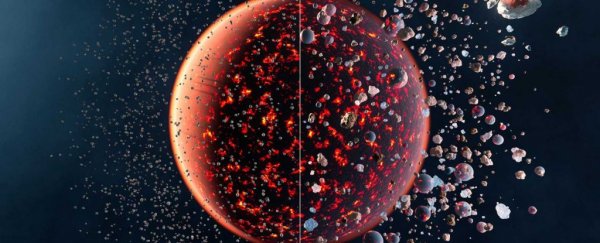You want to know something funny? We don't actually know how our planet formed. We have a broad general idea, but the finer details are a lot trickier to unravel.
We do have a model that is currently accepted as the most likely explanation so far: that Earth formed from the gradual accretion of asteroids. However, even here, there are some facts about the formation of our planet that are challenging to explain.
A new paper, combining experimentation with modeling, has revealed a new formation pathway that much more neatly fits the characteristics of Earth.
"The prevailing theory in astrophysics and cosmochemistry is that the Earth formed from chondritic asteroids. These are relatively small, simple blocks of rock and metal that formed early on in the Solar System," said planetologist Paolo Sossi of ETH Zurich in Switzerland.
"The problem with this theory is that no mixture of these chondrites can explain the exact composition of the Earth, which is much poorer in light, volatile elements such as hydrogen and helium than we would have expected."
There's a whole bunch of question marks over the planet formation process, but scientists have been able to piece together a general picture. When a star forms from a dense clump of matter in a molecular cloud of dust and gas in space, the material around it arranges into a disk that orbits and spools into the growing star.
That disk of dust and gas doesn't just contribute to the waistline of a growing star – small densities within that swirl also aggregate into smaller, cooler clumps. Small particles collide and stick together, first electrostatically, then gravitationally, forming larger and larger objects that can eventually grow into a planet. This is called the accretion model, and it's strongly supported by observational evidence.
But if the rocks that stick together are chondrites, that leaves a big open question about the missing lighter, volatile elements.
Scientists have posed various explanations, including heat generated during the collisions that could have vaporized some of the lighter elements.
That, however, doesn't necessarily track either: heat would have vaporized lighter isotopes of elements, with fewer neutrons, according to recent experimental work led by Sossi. But lighter isotopes are still present on Earth in roughly similar ratios to those found in chondrites.
So Sossi and his colleagues set out to investigate another possibility: that the rocks that combined to make Earth were not chondritic asteroids from Earth's general orbital neighborhood, but planetesimals. These are larger bodies, the "seeds" of planets that have grown to a size large enough to have a differentiated core.
"Dynamic models with which we simulate the formation of planets show that the planets in our Solar System formed progressively. Small grains grew over time into kilometer-sized planetesimals by accumulating more and more material through their gravitational pull," Sossi said.
"What is more, planetesimals that formed in different areas around the young Sun or at different times can have very different chemical compositions."
They ran N-body simulations, altering variables such as the number of planetesimals, along the "Grand Tack" scenario, in which a baby Jupiter moves first closer to the Sun, and then back again to its current position.
Under this scenario, the motion of Jupiter in the early Solar System had an extremely perturbing effect on the smaller rocks swirling around, scattering planetesimals into the inner disk.
The simulations were designed to produce the inner Solar System we see today: Mercury, Venus, Earth and Mars. The team found that a diverse mixture of planetesimals with different chemical compositions could reproduce Earth as we see it today. In fact, Earth was the most likely outcome of the simulations.
This could have important implications not just for the Solar System, and understanding the varying compositions of the rocky planets therein, but other planetary systems elsewhere in the galaxy.
"Even though we had suspected it, we still found this result very remarkable. We now not only have a mechanism that better explains the formation of the Earth, but we also have a reference to explain the formation of the other rocky planets," Sossi said.
"Our study shows how important it is to consider both the dynamics and the chemistry when trying to understand planetary formation. I hope that our findings will lead to closer collaboration between researchers in these two fields."
The team's research was published in Nature Astronomy.
